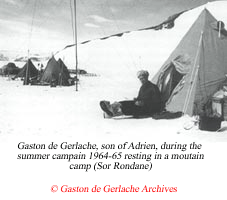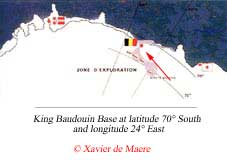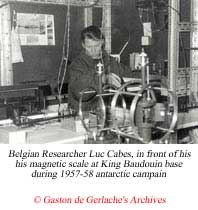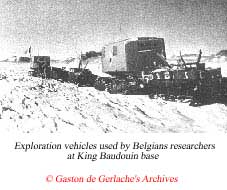|
  
|
 |






|
 Antarctic Polar Regions | A short History of the Antarctic Antarctic Polar Regions | A short History of the Antarctic
Return to Antarctica (Page 1)
 |
|
Like father, like son ?
On 12th November 1957, sixty years after his father, Adrien, departed for what was to be the first southern over-wintering in history, the reserve airforce commander, Gaston de Gerlache left the port of Antwerp at the head of a major Belgian scientific expedition that was also bound for the Antarctic.
Like father, like son, they say...
He was asked a hundred times, a thousand times, about the reasons that prompted him to return there; and a thousand times Gaston de Gerlache replied that he had never wanted to follow in the footsteps of his father, nor had he even thought about setting off southwards, like his father before him, to explore the polar regions on behalf of his country. 
"Sure, I grew up around memories of the Belgica," he says in the introduction to his book Return to Antarctica. "I had always been fascinated by a marvellous model of the ship. The loft in my father's house was stuffed with sledges, harpoons, snowshoes and clothes made from reindeer skin. My father twice took me on cruises to the North. When I was twelve, I saw the icepack and my first icebergs, well beyond Spitzbergen... No doubt I dreamt about being an explorer, which I thought had to be the greatest job in the world, but I never for one moment thought I could recreate a Belgian Antarctic expedition. My father was modest and taciturn and he never talked about his adventures - even to his children. I was fifteen when he died. And I was heading for a military career."
Apart from the fact that Adrien Gerlache wanted to be an explorer while his son aspired to the military, the paths taken by the two men and the circumstances that surround them nonetheless bear marked similarities.
At the end of the 19th century, it was the 6th International Geography Congress in London (1895) that sowed the seeds with the young Gerlache and, to some extent, was the trigger for what was to happen later. A little over half a century later, it was the invitation sent out by the International Council of Scientific Unions (I.C.S.U.) to take a greater interest in Antarctica and participate in the International Geophysical Year that prompted Gaston de Gerlache to commit Belgium to the construction of a permanent scientific base in Antarctica.
|
1957-1958 : International Geophysical Year
The International Geophysical Year (IGY) was an event of the greatest importance in the domain of international scientific collaboration. It was the event behind the signing of the Antarctic Treaty and the development of the conquest of space. Created in 1952 at the behest of the International Council of Scientific Unions, I.C.S.U., IGY committed those nations with an interest in the Antarctic to set up a maximum number of simultaneous geophysical observation programmes, from 1st July 1957 to 31st December 1958. It was a period deemed to be suitable by specialists on account of the intensity in solar activity that was forecast to be at its height between the two dates. Two international polar years had been held in the past (one in 1882-83 and the other in 1932-33), but these were only in relation to the Arctic. Twelve nations took part in the IGY project by building 40 bases on the Antarctic continent (including one Russian station at the most inaccessible point, furthest from all the Antarctic coasts) and 20 other on Antarctic and sub-Antarctic islands.
The term "geophysics" is one of those cryptic words that science creates to give a precise definition to what it is involved in. However, geophysics - at the time called "Global Physics" - is an idea that is simple to define. It is the study of the Earth using the physical resources available to mankind. Because those resources are considerable and the Earth is a vast subject to research, geophysics is made up of a number of very distinct areas. Without claiming to be exhaustive, because as new discoveries are made, these areas become subdivided to the point where it becomes increasingly difficult to know exactly who is studying what. Here are a few examples: the Earth's magnetism (geomagnetism), geodetics, study of the outer atmosphere, earthquakes (seismology), study of volcanoes (vulcanology), meteorology, study of water, seas, ice (hydrology), etc. Mountain observatories, radiosondes, rockets, drifting balloons, drifting buoys, Antarctic bases, oceanography ships, satellites (geostationary and others), etc. There you have just some of the tools of geophysics. |
Another similarity between the two adventures was that the airman was up against the same obstacles as his father when it came to finding the funds needed to leave - for example, like his father, Gaston had to resort to a method of public subscriptions in order to raise the money required to fund the expedition's coffers. However, the budget finally granted by the government was comfortable enough: 54 million francs - 40 million of which was approved at the eleventh hour by members (thanks to the support of the royal family, in fact), 7 million was granted in the form of private subsidies, and the remaining 7 million came from free loans or donations. Then there was all the direct assistance in terms of equipment: fuel, travel, loading ships, measuring tools, medicine, radio and audio-visual equipment, etc. Sixty years previously, Gerlache senior's expedition had cost 344,000 francs!
Of course, you cannot compare the budget of a small country with the resources that major nations can mobilise. The United States, for example, took advantage of IGY to set up a permanent base at the South Pole - the Amundsen-Scott base, which still exists today; while the New Zealanders set themselves the task of making the first crossing of the continent via the pole. 
Having said that, Belgium had nothing to be ashamed of the expedition that set out from the port of Antwerp on 12th November 1957. Gaston de Gerlache chartered two Norwegian ships to transport his men and equipment and to return to collect them: the Polarhav - 658 tons deadweight, 54.5 metres long with a beam of 9.6 metres - was a brand-new ice-breaker, complete with automatic pilot and radar. The second vessel, the Polarsirkel, was a 500-ton seal hunter that had already taken a Norwegian expedition to the Antarctic a year earlier. Aboard these two ships were loaded 440 tons of equipment packed in 2,350 crates, 850 barrels of fuel, three tracked vehicles, an aeroplane and a helicopter.
Alongside this array of technology, the expedition was made up of 17 men - most of them scientists; they had all agreed to spend fifteen months in Antarctica, shut up inside tiny huts, with the barely reassuring prospect of an endless polar night to round things off. In the contract that Gerlache junior had each of his men sign, it was stipulated in particular: "the signatory undertakes to carry out, at any time and to the best of his ability, any work deemed of value to the expedition that may be asked of him by the expedition leader or his representatives..."
On hands and knees
On 26th December 1957 came the first major great thrill: disembarking in Queen Maud Land. Imagine the two ships cutting a path by zigzagging through the pack ice; through binoculars, the men are trying to get a glimpse of what could be the cliff of ice heralding the fact that terra firma is not far away. Then the pack ice closes in gradually, making navigation difficult... Finally, after much hesitation, comes the order to shut off the engines and the ship comes alongside a key hewn from ice in the bay that was later to become King Leopold III Bay. Then comes the reconnaissance on foot into a part of the continent where no man has ever been before, the captain's decision and the unloading the equipment - which is a delicate operation when you realise that there is only a metre and a half of ice under your feet. The comings and goings of snowmobiles is incessant between the disembarcation area and the shelf in the ice selected to receive the 2,300 crates so that the KBB (King Baudouin Base) can be installed. For Gerlache and his companions, it is a historic moment.

As though the continent had decided to welcome them in a manner worthy of its reputation, a blizzard driven by winds in excess of 120 km/h blew for 14 days after the expedition landed. Before the process of unloading was even complete, the scene was one of indescribable chaos. The roof of the huts just about fell apart, the storage areas that were more or less in place were buried under two metres of snow, a flying panel managed to hit the aeroplane and damage its steering gear, etc. Outside, visibility was barely a metre, the wind took the breath away from anyone who ventured out, where the only way of getting about was on hands and knees; the cellar/cold-room that had taken two days to dig, was totally full in a matter of hours. In a word, the men experienced 48 hours of hell. Welcome to Antarctica...
A few days later, scientific observations began. You have to remember that during the Belgica expedition, the men had begun very early in the voyage between Tierra del Fuego and the Antarctic peninsula to carry out their first oceanographic measurements. It was with the same sense of urgency that, 60 years later, de Gerlache's companions opened the crates, unwrapped the tools, set up the partitions that were to house the laboratories, assemble the measuring instruments and erect the first antennas. Why such a hive of activity when they had more than a year ahead of them? Because the Belgians had set out a year after the other international expeditions. This was because the MPs had shaved bits off the budget at the last minute. So they had to make up for lost time. No sooner said, than done; a month after stepping off the ship, the automatic recording of the first readings of radioactivity in the air had taken place. Ditto for the first measurements of atmospheric electricity and solar radiation. On 22nd February, two plexiglas domes were set up, one for the observer and the other for the panoramic camera. Now Jacques Loodts, engineer and geodesist, could observe the magnificence of his first Southern Lights display. At the other Antarctic bases set up as part of IGY, installation took an average of 7 months; at the Belgian base, eight weeks after the men arrived on site, the scientific instruments were already operating.
70°25'33" latitude south: comfort
It is now time to pay a visit (see plan opposite). The King Baudouin base was built more or less in the shape of a big "L". The short horizontal bar of the letter represents the main Quarters building; it is 6.10 m wide and 31.70 m long and houses the radio room, the bedrooms (Gerlache insisted that each person should have his own private space, no matter how small), library, kitchen and living area. The upright stroke of the "L" is a corridor measuring 1.20 metres by 51.15 metres, built using the crates of supplies piled up on one another, with a roof made from partitions and tarpaulins. In the centre and located on the same side as Quarters, is the Power room, 32 sq.m. in floor area, the technical heart of the base,  because this was where the three electricity generators, water tanks and workshop of the station are located. For additional safety, the room is equipped with an anti-fire system. A few metres from Power, on the same side of the corridor, is the small area intended for the production of hydrogen and for releasing balloon probes. At the end of the corridor, there is a perpendicular section, 10 metres by 4, built in the opposite direction to Quarters: this is the third and last room at the base, called Science and considered as the nerve centre of the King Baudouin base. This is where the expedition leader's office is located (where he keeps the firearms), the two observation domes, the weather room, the photo laboratory, the sick-bay and various scientific instruments such as the ionosphere probe, "an electronic monster that, like a museum piece, can be admired from every side, occupies a central position in the room". because this was where the three electricity generators, water tanks and workshop of the station are located. For additional safety, the room is equipped with an anti-fire system. A few metres from Power, on the same side of the corridor, is the small area intended for the production of hydrogen and for releasing balloon probes. At the end of the corridor, there is a perpendicular section, 10 metres by 4, built in the opposite direction to Quarters: this is the third and last room at the base, called Science and considered as the nerve centre of the King Baudouin base. This is where the expedition leader's office is located (where he keeps the firearms), the two observation domes, the weather room, the photo laboratory, the sick-bay and various scientific instruments such as the ionosphere probe, "an electronic monster that, like a museum piece, can be admired from every side, occupies a central position in the room".
Outside, at a respectable distance from the quarters, are two hangars, one for the aeroplane, the other for the helicopter; closer, is a tower made from hollow metal tubes (that have been pushed into the ice by pouring hot water in first). It is 6 metres high and has been erected to house the radiotheodolite, numerous masts for the various antennas (some of which are up to 27 metres high!) and a small room for the emergency equipment. 150 metres from the main buildings, in a zone cut off from the rest and extending to a hectare in area, forbidden to any metal object, are the two geomagnetism huts.
Comfort at the base is relative but nonetheless appreciable: there is electricity and central heating (pumped hot air) in all of the rooms, as well as running hot and cold water; for washing, there is a shared mini-bathroom and plastic containers to act as individual basins. Every morning at 7.30 am, the person designated by the community as the skivvy for the day (in charge of domestic tasks on a rota basis), puts the record of his choice on the record-player and wakes up the small band of men. There will be music playing throughout the day...
Never a dull moment in the Antarctic...
The men on the expedition knew it before they left: they came to Antarctica to get through a maximum amount of work. Certainly there is leisure time (cards, discussions, drinks, lectures, outings on to the ice, music, reading), but it is a succession of scientific observations that take up the majority of the men's energy. To gain an idea of how long it takes for an everyday task, let's take the example of launching the balloon probes: it takes two hours to make the hydrogen that will take the balloon into the upper atmosphere, two hours to launch it through the roof (making sure the sides of the balloon do not touch the edges of the porthole, otherwise you have to start all over again) and two hours to go through all of the information gathered by the probes in the radio room (air pressure, temperature, humidity, etc). Added to that is the fact that there are two radiosondes a day - frequencies dictated by the IGY's programmes - and the obligation of the meteorologists to send the finding from their probes via the radio operator and the Australian Mawson base to Little America, the American base that had the responsibility for centralising the data for the IGY and gradually building up synoptic weather charts for the whole of the continent. Then there is a figure that says a great deal about how the scientists' time was spent in the Antarctic: at the King Baudouin base alone, thanks to the perseverance of the expedition's second-in-command and weather chief, Xavier de Maere, 646 radiosondes were carried out up to 31st December 1958!
What work did the meteorologists do? A single example from many others. At King Baudouin, all of the scientists had their time carefully recorded. For instance, Jacques Loodts and Gerlache hardly had any sleep at night because of the displays of aurora australis (Southern Lights).
The team also included Henri Vandevelde (specialist in the ionosphere and radio communications), who looked after this ionosphere probe with particular care; he measured the height, density and variations of the various ionospheric layers in the atmosphere. These layers, which occur at altitudes of between 60 km and 1,000 km, form what is known as the ionosphere because they cover an area where the interaction between the streams of solar radiation and the neutral molecules that they encounter in the atmosphere is filled with ions (an ion is an atom that carries an electrical charge); without the ionosphere, there would be no long-distance radio communications and so no contact with Belgium. As Vandevelde realised that the layers changed in nature rapidly, he decided of his own initiative to amplify the IGY programme...
Another important character was Luc Cabes, a 50-year-old engineer specialising in geomagnetism, whose job it was to observe magnetic storms. It is of particular interest to check whether the variations in the magnetic field are identical, and even simultaneous, in northern and southern polar regions. To carry out this work, the order that reigned in the geomagnetism huts was virtually military. "They are palaces of marble and copper, but also of cleanliness and order," related Gerlache. "Woe betide any visitor who does not sweep the snow from his shoes before entering... It takes a few moments to become accustomed to the dark, then you can see a multitude of little luminous prisms that twinkle and reflect the movements of the magnetic balances on to photographic paper. The ambient temperature is kept at 5° by electrical resistors. All of the equipment is placed on marble slabs resting on asbestos supports embedded in the ice. These supports are not always as stable as they might be, because the ice sometimes gives a little. When that happens, the prisms have to be reset. Fortunately Cabes is a patient man, well used to making long and painstaking adjustments; we often worry about him because he lets meal times pass by. He has an alarm bell in his hut that can warn us if he is unable to get out. It is meant to ring in the Science building, but we are afraid of not hearing it will go of our own accord to see what is happening. Our geomagnetician is simply hard at work with his balances and prisms and has lost track of the time". When he was not adjusting his instruments, Cabes would head for his other hut to take readings of magnetic variations. These two laboratories were located 150 metres from the base; the path to them had to be marked out and a rope had to be placed between HQ and the perimeter of the area where iron was forbidden; if it wasn't for that, Cabes ran the risk of getting lost if there was a blizzard.
We should also mention the Italian, Edgard Picciotto, who used complex devices to measure the radioactivity in the air and who handled the glaciology programme. This involved calculating the accumulation of snow on the ice by distinguishing amounts generated by precipitation from snow blown in on the wind. He would then examine the ice crystals under his microscope. The chapter on "A base that lives, a base that dies" provides more details on how the research carried out by this Italian scientist living in Belgium left its mark on the development of glaciology.
TO BE CONTINUED NEXT PAGE
---------------------------------------------------------------------------

Following sources have been consulted to write this article :
Antarctique, la grande histoire des hommes à la découverte du continent de glace, Sélection du Reader's Digest.
Antarctica, the extraordinary history of man's conquest of the frozen continent, Reader's Digest Association Limited, Australia, 1985
The Explorations of Antarctica the last unspoilt continent, G.E. Fogg & David Smith.
Quinze mois dans l'Antarctique, Adrien de Gerlache.
Victoire sur la nuit antarctique, Adrien de Gerlache.
L'Odyssée de l'Endurance, première tentative de traversée de l'Antarctique, Sir Ernest Shackleton.
Explore Antarctica, Louise Crossley.
Au coeur de l'Antarctique, Vers le pôle sud, 1908-1909, Sir Ernest Shackleton.
Explorateurs et Explorations, Raymond Cartier.
|




 because this was where the three electricity generators, water tanks and workshop of the station are located. For additional safety, the room is equipped with an anti-fire system. A few metres from Power, on the same side of the corridor, is the small area intended for the production of hydrogen and for releasing balloon probes. At the end of the corridor, there is a perpendicular section, 10 metres by 4, built in the opposite direction to Quarters: this is the third and last room at the base, called Science and considered as the nerve centre of the King Baudouin base. This is where the expedition leader's office is located (where he keeps the firearms), the two observation domes, the weather room, the photo laboratory, the sick-bay and various scientific instruments such as the ionosphere probe, "an electronic monster that, like a museum piece, can be admired from every side, occupies a central position in the room".
because this was where the three electricity generators, water tanks and workshop of the station are located. For additional safety, the room is equipped with an anti-fire system. A few metres from Power, on the same side of the corridor, is the small area intended for the production of hydrogen and for releasing balloon probes. At the end of the corridor, there is a perpendicular section, 10 metres by 4, built in the opposite direction to Quarters: this is the third and last room at the base, called Science and considered as the nerve centre of the King Baudouin base. This is where the expedition leader's office is located (where he keeps the firearms), the two observation domes, the weather room, the photo laboratory, the sick-bay and various scientific instruments such as the ionosphere probe, "an electronic monster that, like a museum piece, can be admired from every side, occupies a central position in the room".